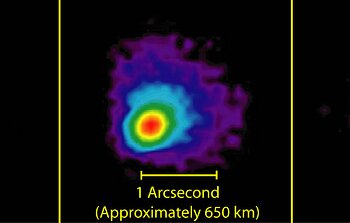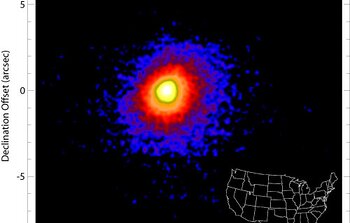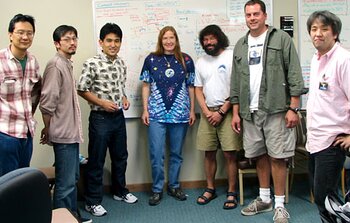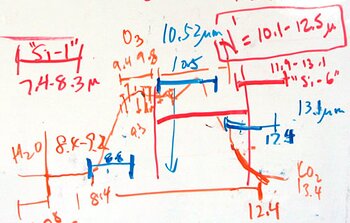Deep Impact Captured by Gemini
July 2, 2005

The Gemini North telescope on Mauna Kea successfully captured the dramatic fireworks display produced by the collision of NASA's Deep Impact probe with Comet 9P/Tempel 1. Researchers in two control rooms on Hawaii’s Big Island (on Mauna Kea and in Hilo) were able to keep enough composure amid an almost giddy excitement to perform a preliminary analysis of the data. They concluded from the mid-infrared spectroscopic observations that there was strong evidence for silicates or rocky material exposed by the impact. Little doubt remains that the unprecedented quality of the Gemini data will keep astronomers busy for years.
“The properties of the mid-infrared light were completely transformed after impact,” said David Harker of the University of San Diego, co-investigator for the research team. “In addition to brightening by a factor of about 4, the characteristics of the mid-infrared light was like a chameleon and within five minutes of the collision it looked like an entirely new object.” Harker’s research partner Chick Woodward of the University of Minnesota speculated further, “We are possibly seeing crystalline silicates which might even be similar to the beach sand here in Hawaii! This data will keep us busy trying to figure out the size and composition of these grains to better understand the similarities and differences between the material contained within comets and other bodies in the solar system.”
In addition to the spectroscopic observations, before-and-after images were also obtained by the Gemini telescope in thermal infrared light and can be seen in Figure 1. Gemini monitored the comet for several weeks prior to the impact and will continue to watch it through the end of July.
The Gemini observations were part of a coordinated effort between the W.M. Keck, Subaru and Gemini Observatories so that each could concentrate on different observations and provide a complete, complementary “picture” of the impact. Astronomers anticipate that the data gathered from the largest and most sophisticated set of telescopes positioned to see the impact will add considerably to our understanding of comets as dynamic probes of our solar system’s early evolution some 4.5-5 billion years ago.
The Gemini observations were made using Michelle, the facility mid-infrared imager/spectrograph built at the Royal Observatory of Edinburgh (ROE) in the UK. The instrument has unique capabilities in the mid-infrared especially at Gemini which uses protected silver coatings on main mirrors to provide exceptional performance in the “thermal” or mid-infrared part of the spectrum.



